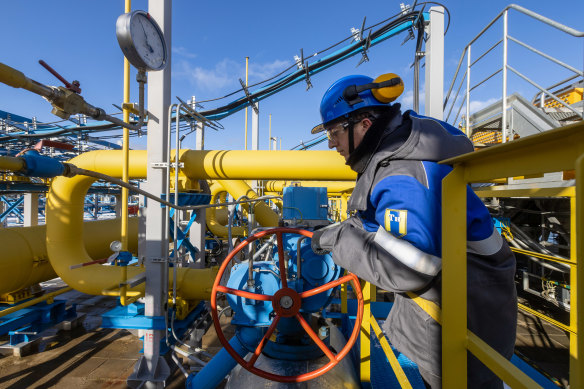
But Europe’s leaders did not comply. When Putin turned down gas supplies, hoping a cost of living crisis would change their minds, instead of coming to an agreement they found sources elsewhere.
Olaf Scholz, Chancellor of Germany, which built much of its industrial prowess on the back of cheap Russian energy, swore the country must “never again” become so beholden to hostile suppliers.
In 2021, more than 40 per cent of European Union gas imports came from Russia. That dropped to 8 per cent last year, according to the European Commission.
In raw volumes, the drop took purchases from just over 150 billion cubic metres to just under 79 billion in 2022 and under 43 billion last year.
Once contracts to supply gas via pipes through Ukraine end, they are not expected to be renewed, slashing Russian sales further.
Norway is now the EU’s biggest supplier of gas imports, raising its sales from 79.5 billion cubic metres to 87.8 billion.
Britain imported little natural gas from Russia before the war – Norway, Qatar and the US were all bigger suppliers – and purchases have since been banned.
Gazprom stopped publishing details of its exports at the start of 2023, but overall its sales outside Russia fell by more than half last year.

Gazprom stopped publishing details of its exports at the start of 2023, but overall its sales outside Russia fell by more than half last year.Credit: Bloomberg
Europe replaced the loss of Russian gas at considerable expense, but new networks have now been established which mean Moscow has lost its grip on the Western market forever.
Liquefied natural gas, imported on tankers, has grown in importance. The EU added capacity to import an extra 40 billion cubic metres of LNG last year, and plans to add capacity for another 30 billion this year.
Bill Weatherburn, commodities specialist at Capital Economics, describes the continent’s efforts as “very successful”.
“Previously it was stable, steady and reasonably cheap pipeline gas, and they have managed to build the infrastructure to import liquefied gas from global markets,” he says.
European imports from the US, flush with gas since its shale fracking boom, have risen from just under 19 billion cubic metres in 2021 to 56.2 billion in 2023.
Qatar provided 15.5 billion cubic metres last year, almost matching British gas sales to the continent.
Weatherburn sees this as “stable, in the sense that the US is going to massively increase its LNG capacity – there will be more available at the end of this year and into next year.”
However, prices risk being less predictable in the coming months.
“An outage in any part of the world will now affect the price of gas in Europe. Last year there were talks of strikes at an LNG facility in Australia. Although Europe doesn’t get LNG from Australia, European prices spiked because there was a risk they would be competing more heavily with Asia for other supplies,” he says.
Europe replaced the loss of Russian gas at considerable expense, but new networks have now been established which mean Moscow has lost its grip on the Western market forever.
Meanwhile Gazprom is scrambling for ways to reach new customers. As with Russian oil, buyers exist who will be happy to take its natural gas without worrying too much about the consequences for Ukraine.
A little gas has been diverted into China and Uzbekistan, but plans to shift more with a major new pipeline are struggling, despite pre-war plans to expand into the Asian market.
Loading
James Waddell, at Energy Aspects, says weaponising gas sales to Europe has left Russia without much of a market.
“Gas is much harder to transport than oil or coal. You have to build very expensive, long pipelines that take years to build, or liquefaction terminals which also take years to build,” he says.
Even attempts to build those LNG terminals are being hammered by Western sanctions.
“Everything that has been lost from Europe has essentially been shut in upstream in Russia, or directed to the local market,” Waddell says.
There is one back door which Putin has made use of: “Russia has ramped up some of its own gas-intensive industries. One of the big ones is urea production, and they are selling lots of fertilisers into Europe,” Wadell says.
Such are the remaining scraps for Putin’s once-mighty gas industry.
Telegraph, London
The Market Recap newsletter is a wrap of the day’s trading. Get it each weekday afternoon.









 Add Category
Add Category